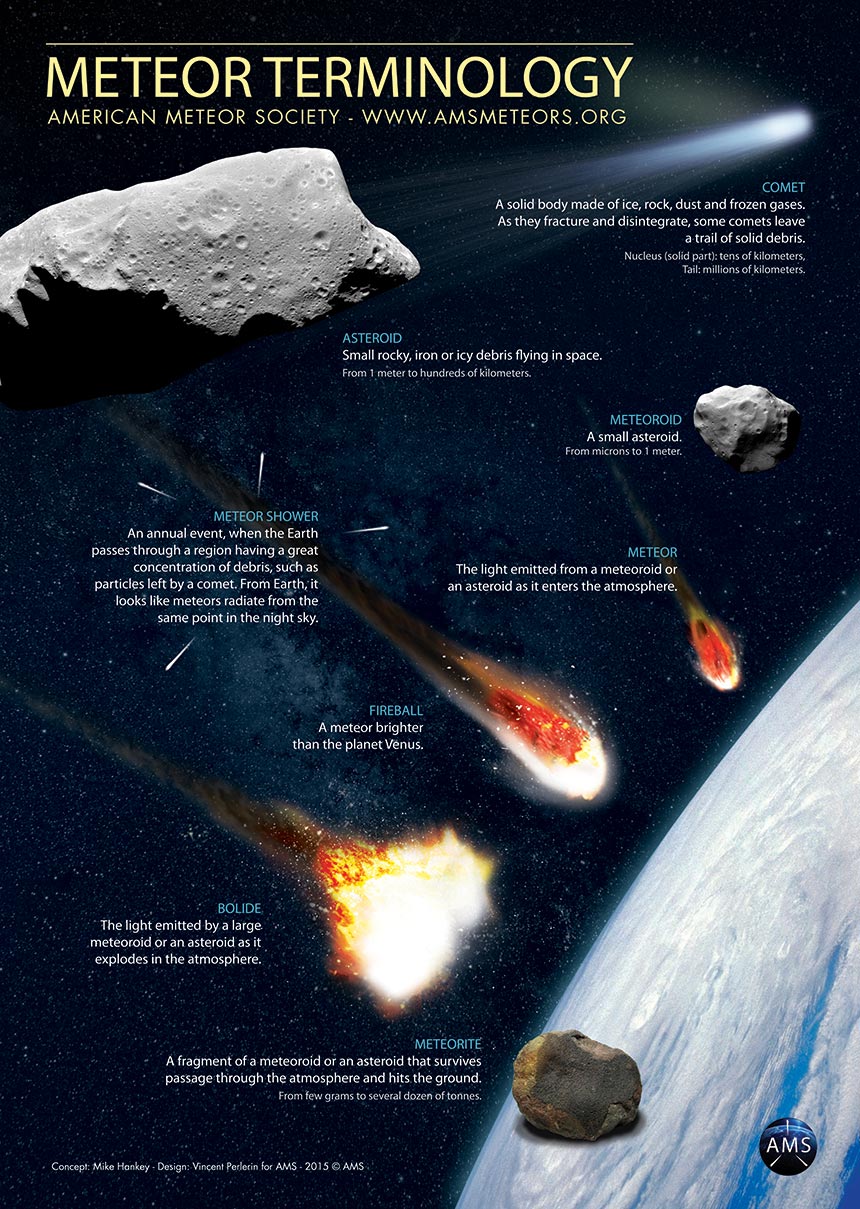Research
Find here details about meteorites.
What are meteorites anyway? Terms like 'meteor', 'comet', 'meteorite', 'fireball', and 'asteroid' are often thrown around without a true understanding of what the actual disctinction is.
Meteorites are defined as "A solid piece of debris from an object that originates in outer space and survives it's passage throught the atmosphere to reach the surface of the planet or moon."

-----------------
"Shooting stars, or meteors, are bits of interplanetary material falling through Earth's atmosphere and heated to incandescence by friction. These objects are called meteoroids as they are hurtling through space, becoming meteors for the few seconds they streak across the sky and create glowing trails.
Scientists estimate that 44 tonnes (44,000 kilograms, about 48.5 tons) of meteoritic material falls on the Earth each day. Several meteors per hour can usually be seen on any given night. Sometimes the number increases dramatically - these events are termed meteor showers. Some occur annually or at regular intervals as the Earth passes through the trail of dusty debris left by a comet. Meteor showers are usually named after a star or constellation that is close to where the meteors appear in the sky. Perhaps the most famous are the Perseids, which peak around 12 August every year. Every Perseid meteor is a tiny piece of the comet Swift-Tuttle, which swings by the Sun every 135 years. Other meteor showers and their associated comets are the Leonids (Tempel-Tuttle), the Aquarids and Orionids (Halley), and the Taurids (Encke). Most comet dust in meteor showers burns up in the atmosphere before reaching the ground; some dust is captured by high-altitude aircraft and analyzed in NASA laboratories."

There are 3 main distincion of meteorites:
- Iron
"Iron meteorites were once part of the core of a long-vanished planet or large asteroid and are believed to have originated within the Asteroid Belt between Mars and Jupiter. They are among the densest materials on earth and will stick very strongly to a powerful magnet. Iron meteorites are far heavier than most earth rocks-if you've ever lifted up a cannon ball or a slab of iron or steel, you'll get the idea." - Stone (Chrondrites and Achondrites)
"The largest group of meteorites is the stones, and they once formed part of the outer crust of a planet or asteroid. Many stone meteorites-particularly those that have been on the surface of our planet for an extended period of time-frequently look much like terrestrial rocks, and it can take a skilled eye to spot them when meteorite hunting in the field. Freshly fallen stones will exhibit a black fusion crust, created as the surface literally burned during flight, and the vast majority of stones contain enough iron for them to easily adhere to a powerful magnet." - Stony-Iron
"The least abundant of the three main types, the stony-irons, account for less than 2% of all known meteorites. They are comprised of roughly equal amounts of nickel-iron and stone and are divided into two groups: pallasites and mesosiderites. The stony-irons are thought to have formed at the core/mantle boundary of their parent bodies."
When Iron meteroites are cut and polished, they display a interlocking crystalline pattern, known as the Widmanstätten Pattern.
Some Stone meteorites coontain special material that originate from Solar Nebulas, and thus are older that the entirety of our solar system.
Some type, Pallasites, are a glassy emerald green color, thus making them very precious and beautiful.
When looking to find the crater size, we need a few certain formulas and some basic information.
"Planetary scientists usually refer the process of impact cratering in three steps: the contact and compression phase, the excavation phase, and the modification phase. In your experiments, the contact and compression phase will take place as the "meteor" hits the target, the excavation phase will take place as the target material is thrown up into the air, and the modification phase will take place as the material that was thrown into the air falls back down."
The diameter of the crater is proportional to the cubed root the kinetic energy of the "meteor" at the time of impact.
D ~ E^(1/3)
You can determine the kinetic energy the "meteor" will have at the time of impact by using the equation.
Kinetic Energy = (1/2)MV2
You can calculate the velocity the "meteor" will have just before it hits the target by using the equation.
(vf)^2 - (vi)^2 = 2ad
Where vf is the final velocity in meters per second (the number you want to solve for to plug into the equation for kinetic energy.